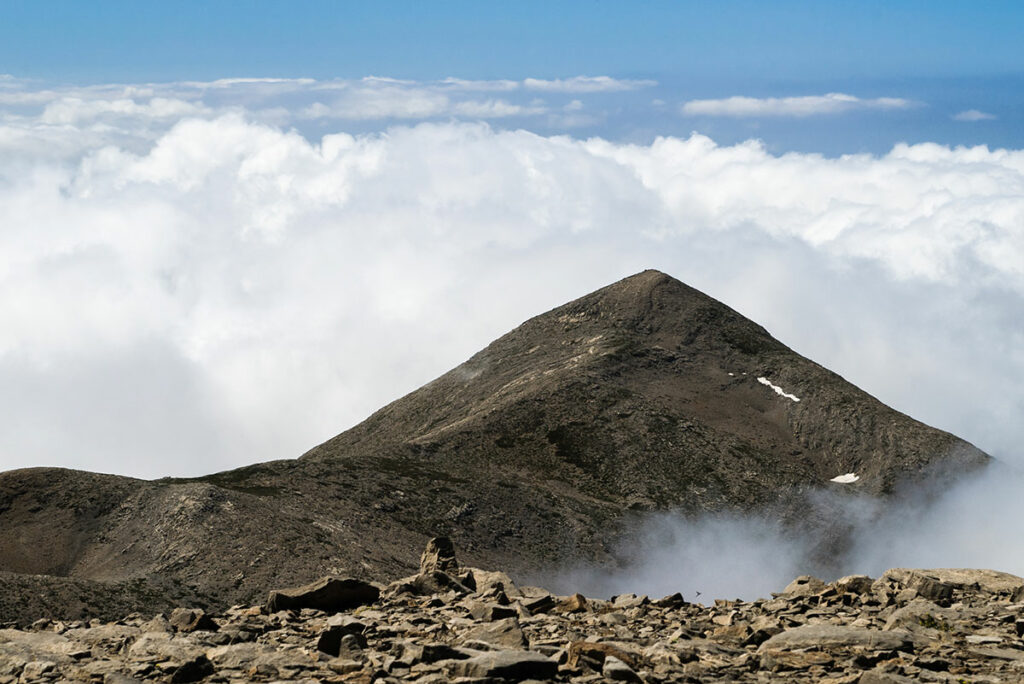Skinakas Observatory has stood on the eponymous peak of the Psiloritis Massif since 1986. The Department of Physics of the University of Crete and the Institute of Astrophysics of the Foundation for Research and Technology – Hellas (FORTH) run this research facility, which features:
- a 1.3m modified Ritchey–Chrétien telescope;
- a 0.6m robotic Cassegrain telescope;
- and a 0.3m Schmidt-Cassegrain telescope.
Skinakas Observatory is at an altitude of 1750 meters above sea level, so even in the summer, the temperatures are lower than what you usually experience at the beach – having windbreaker or warm clothes is a clever idea. You will also need good hiking shoes because the terrain surrounding the observatory building is rocky and uneven in places. If you want to walk to explore the area, you will find the experience strenuous and challenging without proper footwear.
The views from the Skinakas Observatory towards Heraklion are awe-inspiring, as you get to see a vast mountainous landscape with villages in the 25 kilometers line-of-sight distance from Skinakas to Heraklion City.
Public tours are only available on open days – usually Sundays in June, July, August, and September (exact dates are available on the Skinakas Observatory website). Presentations are in Greek but depending on the available time and the number of visitors, there may be a short English commentary, too.
You should also know that the observatory attracts large crowds during its open days, and you may need to stand in line for a long time for a chance to gaze at the skies through the 1.3m Ritchey–Chrétien telescope. In addition, some open days may feature live music besides guided tours and presentations, making the experience even more enjoyable, especially while waiting to get in.
Access to the observatory is difficult and time-consuming, even by car – the drive from Fodele Beach & Water Park Holiday Resort is more than 50 kilometers and lasts more than an hour and a half. In addition, mountain bikers use the main road to reach the observatory, too.
Many hikers and mountaineers use trails to visit this research facility on Skinakas Peak – for example, on the Gergeri – Skinakas Observatory route, which is also suitable for mountain biking. However, for hikers, the 49.9-km out-and-back trail poses moderate difficulty through the Cretan countryside and Mt. Psiloritis.

You can combine your visit to the Skinakas Observatory with a road trip to other attractions in the region:
- Cave Ideon Antron (also the Idaean Cave): About six kilometers northwest of the observatory, you can visit the Cave Ideon Antron, on the eastern slopes of Mount Ida, above the Nida Plateau. According to Cretan and Greek legends, this is where Zeus grew up, hidden from his father, Cronus. Despite the high altitude of the cave, 1538 above sea level, it attracts hundreds of tourists every summer. Although its interiors are not impressive for spelunkers, the cave has significant mythological and cultural value for Cretans and Greeks.
- Anogia Village: A traditional mountain village, 700 meters above sea level, known for folk music and weaving – see the embrAnogia center for embroidery, and hand and loom weaving. Attractions in the village include:
- Alcibiades Koulas Museum, dedicated to painter and sculptor Alcibiades Koulas, who was born in Anogia;
- House of Nikos Xylouris – a museum in the home of the late Nikos Xylouris, a famous local Cretan lyra musician known as the Archangel of Crete.
- Anogia Monument for the Fallen – 1822, 1867, 1944.
- Several traditional Cretan tavernas and cafes, especially in the main village square.
- Sfendonis Cave (also known as Zoniana Cave or Sfendoni’s Hole): You will find it in the Psiloritis Natural Park – UNESCO Global Geopark, on the southern slopes of Halepa Hill at an altitude of 630 meters above sea level, in the Mylopotamos municipality. The cave features spectacular columns, stalactites, stalagmites, water basins, and cave pearls. Access for disabled persons and the public is easy on steel, illuminated walkways with ropes. The cave, one of the most beautiful in Greece, is a natural habitat for four species of bats and several species of invertebrates.
There are many other attractions in this part of Crete: if you plan, you will get to see plenty and have an inspiring experience. Note that the Skinakas Observatory only offers evening access to the public on its Open Days, so plan to visit everything else starting early morning.
